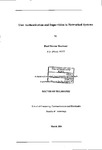User Authentication and Supervision in Networked Systems
| dc.contributor.author | Dowland, Paul Steven | |
| dc.contributor.other | Faculty of Science and Engineering | en_US |
| dc.date.accessioned | 2013-10-07T10:47:23Z | |
| dc.date.available | 2013-10-07T10:47:23Z | |
| dc.date.issued | 2004 | |
| dc.identifier | NOT AVAILABLE | en_US |
| dc.identifier.uri | http://hdl.handle.net/10026.1/2059 | |
| dc.description.abstract |
This thesis considers the problem of user authentication and supervision in networked systems. The issue of user authentication is one of on-going concern in modem IT systems with the increased use of computer systems to store and provide access to sensitive information resources. While the traditional username/password login combination can be used to protect access to resources (when used appropriately), users often compromise the security that these methods can provide. While alternative (and often more secure) systems are available, these alternatives usually require expensive hardware to be purchased and integrated into IT systems. Even if alternatives are available (and financially viable), they frequently require users to authenticate in an intrusive manner (e.g. forcing a user to use a biometric technique relying on fingerprint recognition). Assuming an acceptable form of authentication is available, this still does not address the problem of on-going confidence in the users’ identity - i.e. once the user has logged in at the beginning of a session, there is usually no further confirmation of the users' identity until they logout or lock the session in which they are operating. Hence there is a significant requirement to not only improve login authentication but to also introduce the concept of continuous user supervision. Before attempting to implement a solution to the problems outlined above, a range of currently available user authentication methods are identified and evaluated. This is followed by a survey conducted to evaluate user attitudes and opinions relating to login and continuous authentication. The results reinforce perceptions regarding the weaknesses of the traditional username/password combination, and suggest that alternative techniques can be acceptable. This provides justification for the work described in the latter part o f the thesis. A number of small-scale trials are conducted to investigate alternative authentication techniques, using ImagePIN's and associative/cognitive questions. While these techniques are of an intrusive nature, they offer potential improvements as either initial login authentication methods or, as a challenge during a session to confirm the identity of the logged-in user. A potential solution to the problem of continuous user authentication is presented through the design and implementation o f a system to monitor user activity throughout a logged-in session. The effectiveness of this system is evaluated through a series of trials investigating the use of keystroke analysis using digraph, trigraph and keyword-based metrics (with the latter two methods representing novel approaches to the analysis of keystroke data). The initial trials demonstrate the viability of these techniques, whereas later trials are used to demonstrate the potential for a composite approach. The final trial described in this thesis was conducted over a three-month period with 35 trial participants and resulted in over five million samples. Due to the scope, duration, and the volume of data collected, this trial provides a significant contribution to the domain, with the use of a composite analysis method representing entirely new work. The results of these trials show that the technique of keystroke analysis is one that can be effective for the majority of users. Finally, a prototype composite authentication and response system is presented, which demonstrates how transparent, non-intrusive, continuous user authentication can be achieved. | en_US |
| dc.language.iso | en | en_US |
| dc.publisher | University of Plymouth | en_US |
| dc.title | User Authentication and Supervision in Networked Systems | en_US |
| dc.type | Thesis | |
| plymouth.version | Full version | en_US |
| dc.identifier.doi | http://dx.doi.org/10.24382/4609 |
Files in this item
This item appears in the following Collection(s)
-
01 Research Theses Main Collection
Research Theses Main


